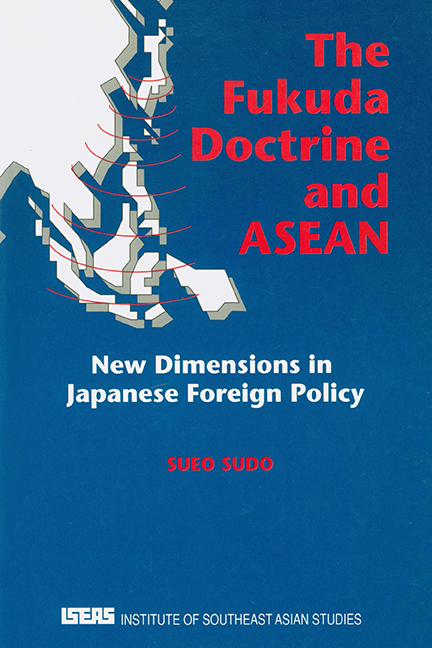Book contents
- Frontmatter
- Dedication
- Contents
- List of Tables
- Preface
- Abbreviations
- Introduction
- chapter one A Framework for Analysing Japanese Policy Towards Southeast Asia
- chapter two Post-war Japan's Re-entry into Southeast Asia
- chapter three Japan's Policy Towards Regional Development
- chapter four External Challenge and Changing Japan-Southeast Asia Relations; 1975–77
- chapter five A Changing Southeast Asia in Japanese Politics
- chapter six Formulating the First Doctrine in Japanese Foreign Policy
- chapter seven Japan's ASEAN Policy, 1977–87
- chapter eight Conclusion
- Appendices
- Bibliography
- Index
- THE AUTHOR
- Frontmatter
- Dedication
- Contents
- List of Tables
- Preface
- Abbreviations
- Introduction
- chapter one A Framework for Analysing Japanese Policy Towards Southeast Asia
- chapter two Post-war Japan's Re-entry into Southeast Asia
- chapter three Japan's Policy Towards Regional Development
- chapter four External Challenge and Changing Japan-Southeast Asia Relations; 1975–77
- chapter five A Changing Southeast Asia in Japanese Politics
- chapter six Formulating the First Doctrine in Japanese Foreign Policy
- chapter seven Japan's ASEAN Policy, 1977–87
- chapter eight Conclusion
- Appendices
- Bibliography
- Index
- THE AUTHOR
Summary
This is a study of Japanese foreign policy towards Southeast Asia in the post-Vietnam war period; with special emphasis on the so-called Fukuda Doctrine of August 1977. Given the controversial nature of the Doctrine, this book attempts a scrutiny of its rationale and developments since 1977 with the view that the Doctrine in fact ushered in a new era in Japan-Southeast Asia relations. In explaining why and how changes in Japan's Southeast Asian policy occurred; four alternative perspectives are introduced: the international system, the regional subsystem, domestic politics, and ideas. These four perspectives are examined in order to assess their relevance in analysing concrete cases.
Having formulated the framework for analysis in Chapter 1, a historical evolution of Japan–Southeast Asia relations is given in the following two chapters for the purpose of comparing pre-Doctrine and current phases. Chapters 4 to 6 constitute the core of the book., which explain how a shift in Japanese foreign policy towards the region came about. Chapter 7 follows up the Fukuda Doctrine period in order to investigate the impact of the Doctrine on Japan–Southeast Asia relations. Finally the nature of the Doctrine and the four perspectives in explaining the shift are discussed, with a conclusion that the Fukuda Doctrine constitutes a major departure from Japan's traditional economic policy towards the region in two dimensions. Playing an active political role and forging a special relationship with the Association of Southeast Asian Nations (ASEAN) are major characteristics of the Doctrine, which continue to be an integral part of Japan's Southeast Asian policy to the present time.
In writing this book, I was greatly assisted by many individuals and institutions, only a few of which can be acknowledged here. First of all, I am indebted to Professors John Campbell and Russell Fifield who helped me immensely to complete my doctoral thesis, which constitutes the main part of this book. I would also like to thank Professor Masashi Nishihara and Masahide Shibusawa, Director of East-West Seminar, for their unstinting comments and guidance.
- Type
- Chapter
- Information
- The Fukuda Doctrine and ASEANNew Dimensions in Japanese Foreign Policy, pp. xi - xiiPublisher: ISEAS–Yusof Ishak InstitutePrint publication year: 1992

